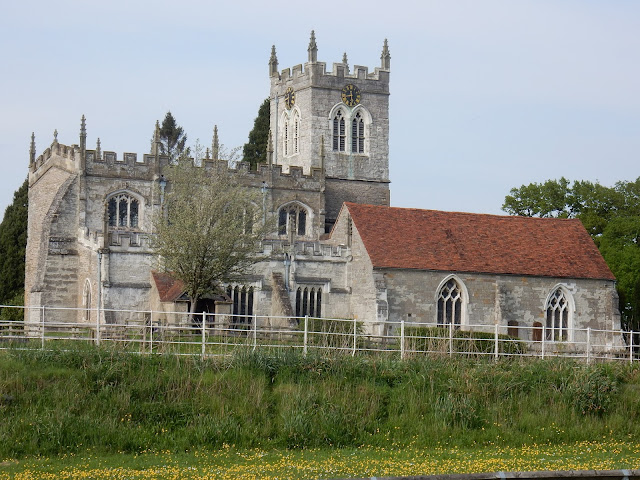We woke up to the lovely smell of wild garlic on the air. The wood next to our mooring was full of the stuff,along with some bluebells.
There were carpets of ramsoms spreading the aroma. The little star like flowers are pretty too.
Just as we were getting ready to let go a boat was seen coming down the lock behind so we waited for them to pass and get a little further along before setting off. As we did there was another boat starting down the lock so we would be in a queue. The countryside was beautiful so it wasn't a chore to pootle along. The boat ahead had four aboard so once they realised that we were behind them they cracked on and we didn't really meet up with them again. The boat behind were a couple of Australians on a Kate Boat hiring for a week. After the first lock we were just leaving when they arrived.
Yaringale Aqueduct was built between 1812 and 1816 and was originally made of wood. In 1834 it washed away when a burst on the nearby Grand Union Canal flooded the stream below the aqueduct. The canal was only closed for a month and the wooden one was replaced with a cast iron trough. It looks like it was from stock as it doesn't actually fit the space. The tow path is below the level of the canal. We carried on for six locks and found a mooring close to Wootton Wawen.
After lunch we set off to explore the village. Our first stop was the church of St. Peters. It is the oldest church in Warwickshire and was founded as a Minster named St. Mary's about 900. In about 1150 the church was re-dedicated to St. Peter in Chains. It is a hotch potch of different periods with some Anglo Saxon and some Norman and other bits. The lady chapel is a barn like thing and currently houses an exhibition of the history of the church and village. The canopied altar tomb above belongs to Francis Smith 1522 to 1605. He had been the Lord of the Manor but was a Catholic even after the Reformation. However he asked to be buried in the church on the site of his family pew.
This chest alabaster tomb has the effigy of a knight John Harwell who died in 1428. His head rests on his helmet and his feet on a spaniel.
The tiled part is the lady chapel of St. Peter's.
We decided to have a walk round the fields down by the River Alne. There are loads of horses there and I can't believe that there are that many young girls to ride them regularly. As it was the flood plain it would have been very muddy but it has been dry for a good while now. That is set to change overnight as rain is forecast. As we passed through the village it would have been rude not to stop for a pint.
At the church we were talking to a lady who sounded just like Susan Carter who runs the Ambridge village Post Office in the Archers. When we got to the pub it was called the Bull. The Archers are based on the land in this area I think so we may be warm!
On the road side of the Wootton Wawen aqueduct has this plaque on it. Actually this is a replica. The original is supposed to be on the tow path nearby.
As you can see this aqueduct is very similar to the on at Yarningale with a cast iron trough and a sunken tow path
This is the view from the road below looking for up towards the Navigation pub and the entrance to Anglo Welsh's base on the left.
We may stay put here tomorrow and see the rest of the sites of the place. And I am going to find out how to pronounce Wawen in Wootton Wawen. Named after a bloke called Wagen who was the last Thane of Wootton before the Norman Conquest.










No comments:
Post a Comment